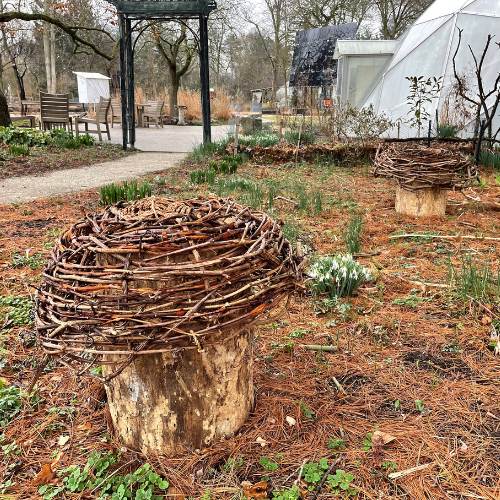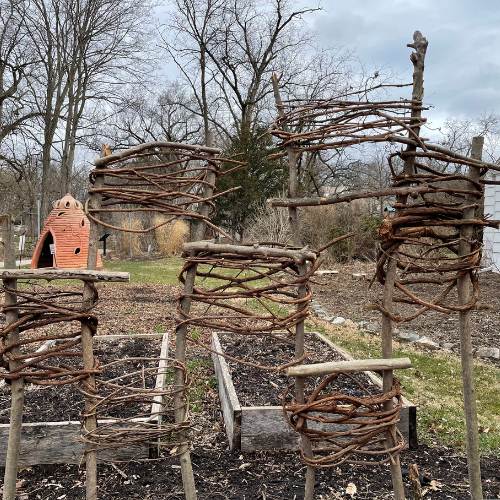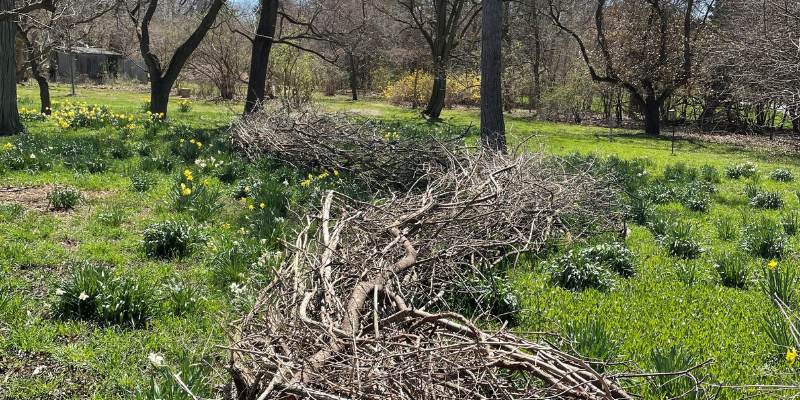Around the Grounds with Samantha
Weaving plant materials has become my dormant season obsession as of late. It started about a year ago when Bennett showed me a picture of Nigel Dunnett’s “dead hedges” on Instagram. They were essentially beautiful serpentine piles of sticks. We thought, “Well, we have sticks too! We should try this.”
February is our major brush-cutting month at 577, the whole Properties team goes out with the chainsaw and hand saws and we remove invasive buckthorn and honeysuckle from areas that are getting choked up. Sometimes we take down small trees as well. This is how the “dead hedge” or “wattle” or “brush serpent” or whatever you’d like to call it, currently residing in our orchard, was born.


I’m not going to lie, it was a lot of work to drag those felled buckthorn and honeysuckle across the lawn to that location. But the weaving aspect of the work was so satisfying for me that it was worth it. We started by spray-painting a serpentine line on the ground, and I laid a layer of large brush along the line. Then, I just started placing the other brush on top of that layer, trying to pin the trunks and stems underneath other trunks, wedging them together until they started holding themselves in place vertically and loosely following a pattern. We let the orchard grass grow tall last summer and called it “The Prairie”. I loved seeing the golden grass and the green grass contrasted with the “brush serpent”.
The term “wattle” to me basically means “weaving outdoors”. It refers to taking woody plant materials and weaving them into a fence or trellis, but the different forms they can take are up to the artist. Personally, I like a mix of very wild and unkept-looking aesthetics mixed in with neat-and-tidy ones. A walk around the grounds will show this style with the dead hedge in the orchard, and a compact little willow wattle near the cabin.


Using these natural materials to decorate and divide the land we live on has several advantages. For one, it’s what our ancestors used, and it’s a sustainable, renewable resource in this climate. Second, it’s softer on my eyes to see the variation in color and shadows in a woven wattle, in an organized pile of brush, or in a stack of logs, as opposed to a straight and uniform wooden picket fence. The woven aesthetic flows with its surroundings, making the plants nearby look even more vibrant in contrast to the grey-brown shadows of wood and sticks. Third, little organized piles of brush provide habitat for tunnel-nesting bees, bumble bees, and beneficial insects who need to stick their egg sac to something through the winter.
Have I convinced you to try one at your home? If you’re able to find a spot in your yard to start a low wall, you could pile any fallen branches and sticks into it periodically when you do yard cleanup. The picture below is from Pinterest, it seems to me like a great idea to get started. You could also cut any logs from trees felled on your property to the same length and stack to make “log walls” for a completely different aesthetic. You can see this at 577 at the bird blind (second photo).


Beyond brush, sticks, and logs, it turns out wild grapevine is an extremely useful design material! I use it all the time. I treasure it, really.
Whenever we take a tree down with grapevine tangled all over the top of it, I save all the grapevine I can. The skinnier pieces are useful for wreaths and baskets, and the larger pieces I save for weaving outdoors. I used wild grapevine to make all the wreath frames for my harvest wreath classes last fall. About a year ago, I wove grapevine into the border around the pond in the dome. This winter, I used a bit of grapevine to weave two mushroom tops for outside the dome.
Bennett (577’s organic landscape horticulturist), Mike Welling (577’s properties team member), and I wove two trellises with grapevine along the brick path to the dome using hazelnut canes as the stakes. They look a little lonely now, but I can’t wait to see them in full summer, contrasted with dense green foliage and brightly colored flowers.



And of course, we may only borrow our inspiration from the original artists….


Written by Samantha Day, 577 Organic Garden Horticulturist



